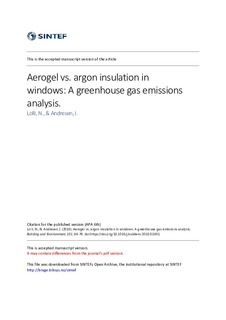| dc.contributor.author | Lolli, Nicola | |
| dc.contributor.author | Andresen, Inger | |
| dc.date.accessioned | 2018-01-22T06:53:05Z | |
| dc.date.available | 2018-01-22T06:53:05Z | |
| dc.date.created | 2016-04-20T09:18:00Z | |
| dc.date.issued | 2016 | |
| dc.identifier.citation | Building and Environment. 2016, 101 64-76. | nb_NO |
| dc.identifier.issn | 0360-1323 | |
| dc.identifier.uri | http://hdl.handle.net/11250/2478583 | |
| dc.description.abstract | The scope of this study is a comprehensive analysis of the greenhouse gas emissions from the partial substitution of triple-glazing units with argon gas (U-value of 0.79 W/m2 K) with double-glazing units with either monolithic aerogel (U-value of 0.65 W/m2 K) or granular aerogel (U-value of 0.31 W/m2d K).
A residential building located near Oslo and fully upgraded with passive house solutions is used as a case study for this analysis. A cradle-to-site analysis is performed on the facade components. Two replacement schedules and three window-to-wall ratios are used to evaluate the differences in total emissions. Sensitivity analyses based on increasing the fraction of the aerogel glazing, varying the greenhouse gas emissions of the aerogel production, and changing the service life of the aerogel glazing are also performed.
Results show that both the options with windows with aerogel are effective in reducing the greenhouse gas emissions, regardless of the total window-to-wall ratio and the replacement schedule used. By increasing the share of the aerogel glazing, the savings in emissions increase from 5% to 9%. The sensitivity analysis shows that the greenhouse gas emissions from the production of aerogel should be at least 8 times higher than those currently reported to totally counterbalance the achieved energy savings | nb_NO |
| dc.description.sponsorship | Acknowledgments. This work has been written within the Research Centre on Zero Emission Buildings (ZEB). The authors gratefully acknowledge the support from the ZEB partners and the Research Council of Norway. Thanks to Anne Grete Hestnes for her helpful comments. | nb_NO |
| dc.language.iso | eng | nb_NO |
| dc.publisher | ScienceDirect | nb_NO |
| dc.rights | Attribution-NonCommercial-NoDerivatives 4.0 Internasjonal | * |
| dc.rights.uri | http://creativecommons.org/licenses/by-nc-nd/4.0/deed.no | * |
| dc.subject | Greenhouse gas emissions | nb_NO |
| dc.subject | Granular aerogel | nb_NO |
| dc.subject | Monolithic aerogel | nb_NO |
| dc.subject | Energy retrofitting | nb_NO |
| dc.subject | Windows | nb_NO |
| dc.title | Aerogel vs. argon insulation in windows: A greenhouse gas emissions analysis | nb_NO |
| dc.type | Journal article | nb_NO |
| dc.type | Peer reviewed | nb_NO |
| dc.description.version | acceptedVersion | nb_NO |
| dc.rights.holder | © 2016 Elsevier B.V. All rights reserved. This is the authors' accepted and refereed manuscript to the article, post-print. Released with a Creative Commons Attribution Non-Commercial No Derivatives License. The final publication is available at https://doi.org/10.1016/j.buildenv.2016.03.001 | nb_NO |
| dc.subject.nsi | VDP::Technology: 500 | nb_NO |
| dc.source.pagenumber | 64-76 | nb_NO |
| dc.source.volume | 101 | nb_NO |
| dc.source.journal | Building and Environment | nb_NO |
| dc.identifier.doi | 10.1016/j.buildenv.2016.03.001 | |
| dc.identifier.cristin | 1351411 | |
| dc.relation.project | Norges forskningsråd: 193830 | nb_NO |
| cristin.unitcode | 7401,30,40,0 | |
| cristin.unitname | Arkitektur, byggematerialer og konstruksjoner | |
| cristin.ispublished | true | |
| cristin.fulltext | original | |
| cristin.fulltext | postprint | |
| cristin.qualitycode | 2 | |

